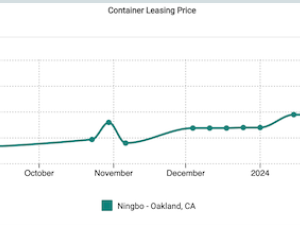Big data helps shipping lines cut fuel bills and emissions
By: Reuters | Apr 29 2015 at 11:00 PM | Liner Shipping
By John Kemp
By focusing on operational improvements, shipping companies are reducing fuel consumption, saving money and cutting greenhouse emissions, while continuing to increase the amount of freight transported.
Maersk Line, the world’s largest container carrier, cut fuel consumption by more than 13 percent between 2012 and 2014, while increasing the number of boxes carried by 11 percent, according to company records.
Maersk’s fuel savings amount to 1.35 million tonnes of fuel per year - and 1.5 million tonnes per year if the increase in freight volumes is taken into account.
The fuel saved by Maersk in 2014 compared with two years earlier is equivalent to almost one day’s total oil consumption in China, or about 10 million barrels.
On its own, the 10 million barrels of fuel saved in a whole year is tiny compared with a global oil market which produces and consumes more than 90 million barrels every day.
But the same fuel optimisation strategies were being applied by hundreds of other shipping companies, as well as airlines, railroads, trucking companies and private motorists.
The result was a large loss in oil demand. And the demand outlook would have worsened even more in 2015 and 2016 if oil prices had not fallen by almost half since mid-2014.
CARBON EMISSIONS
Maersk has committed itself to the UN goal of decoupling forecast growth in global trade from greenhouse emissions (“Maersk Sustainability Report” Feb 2015).
The container line has reduced greenhouse emissions per container moved nearly 40 percent since 2007 and is committed to a target reduction of 60 percent by 2020.
The company expects an 80 percent increase in volumes by 2020 compared with 2007, so a 60 percent improvement in efficiency would cut container-related emissions by 40 percent.
Maersk is already one of the greenest lines, with carbon dioxide emissions of just 46.7 grams per container per kilometre compared with an industry average of 58.3 grams.
By 2020, however, Maersk plans to cut its emissions to just 30.8 g per container-kilometre, almost half the current industry average.
VOYAGE CENTRE
Maersk gives much of the credit for fuel and emissions reductions to its Global Voyage Centre, which monitors fleet operations round the clock from a situation room in Mumbai.
“The team is watching to ensure that the vessels keep to their optimum voyage speed. Too fast means an early arrival at the port, which costs a lot of money; too slow and the ship has to speed up to arrive on time, which means huge fuel wastage,” the company explained in a fascinating internal publication about the impact of big data on its operations.
Every ship is connected to shore via the global positioning system and satellite communications. “We can monitor the speed, the fuel efficiency and even the weather conditions,” the situation room leader said (“The data drive” Feb 2015).
The sustainability report explains how experienced seafarers in the control room “compare each ship’s voyage plan to the best-in-class (plan) stored in their database, ensuring the ship keeps to the plan and following up when deviations occur.”
Maersk gives an example of an alarm sounding in Mumbai to warn that a ship in the North Sea is travelling one-knot over her optimum speed, enabling the control room team to contact the captain to find out why.
TRIPLE-E CARRIERS
Maersk has also been introducing larger, more fuel efficient, container ships into its fleet, boosting capacity and freight volumes while reducing fuel consumption.
Maersk’s giant new Triple-E container carriers were the largest container ships ever built, until they were overtaken by slightly bigger mega-carriers in late 2014.
Every aspect of the Triple-E has been designed to lower costs, fuel bills and emissions. The wider hull shape has been optimised for much slower speeds to cut fuel consumption.
The Triple-E engines have been specifically designed for slower propulsion (with the maximum speed capped at 23 knots rather than 25) which means it uses less power and fuel than the smaller E-class vessels which came before it.
Triple-E’s have thousands of sensors built into the main control system and engine room, measuring temperature, pressure and operations.
On board sensors record the ships position and motion every half-second and transmit the information back to the control room in real time to enable voyage optimisation.
Although Maersk is more advanced than most of its rivals in cutting fuel consumption and emissions, in the competitive container market the same operational approaches will spread across the industry.
LOWER OIL DEMAND
Maersk’s drive to increase fuel efficiency and reduce emissions provides a useful case study for what has happened in the oil market over the last five years and some clues about the outlook for the next five.
The company’s obsessive focus on fuel and emissions stems from the surge in oil prices as well as an increasing awareness of the need to be seen to play a part in tackling global warming.
Without the surge in fuel costs between 2002 and 2014, it is unlikely Maersk and other container lines would have invested so heavily in a new class of mega-carriers and emphasised operational improvements like the Global Voyaging Centre.
The reduction in fuel consumption by Maersk and other container carriers as a result of operational efficiency helps explain why oil demand started to soften in 2013/14.
Coupled with the rise in U.S. shale oil production, demand destruction was pushing the oil market towards a large supply surplus.
Following the fall in oil prices since mid-2014, lower fuel costs should help slow the efficiency drive, even if they cannot stop it completely.
Carriers such as Maersk are still committed to cutting fuel consumption and emissions but the reductions may come more slowly if oil prices remain sufficiently low.
However, with less pressure from fuel prices, continued improvements in fuel efficiency and emissions will rely more heavily on regulatory and voluntary action by the shipping lines themselves.






